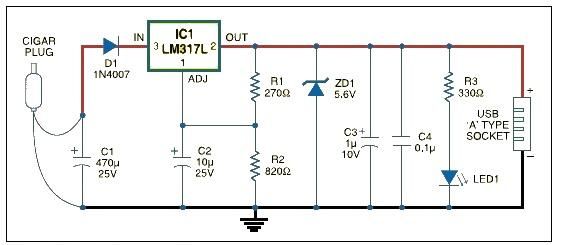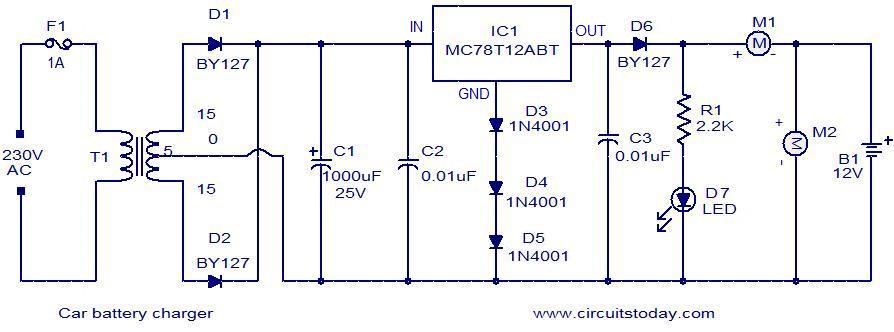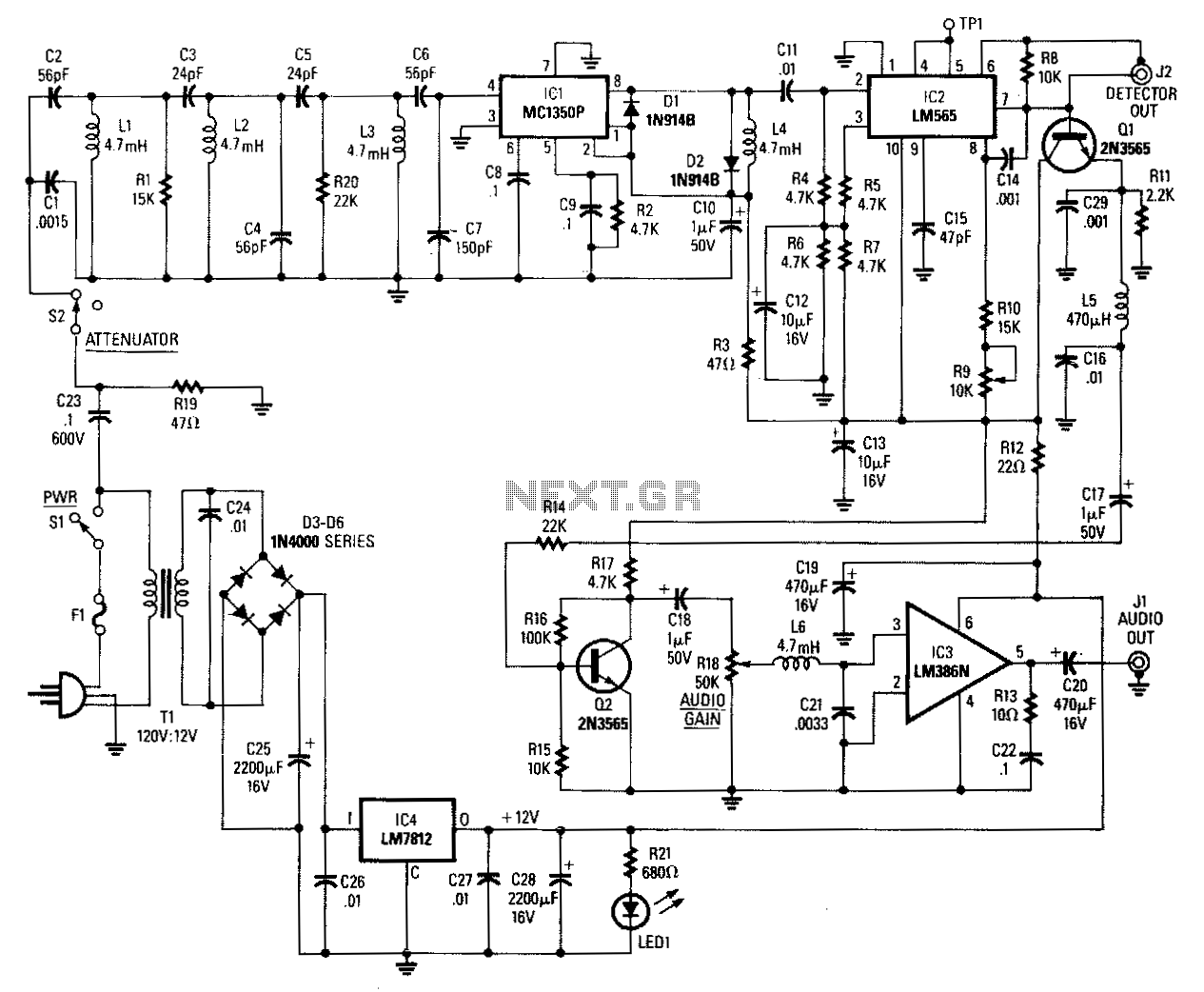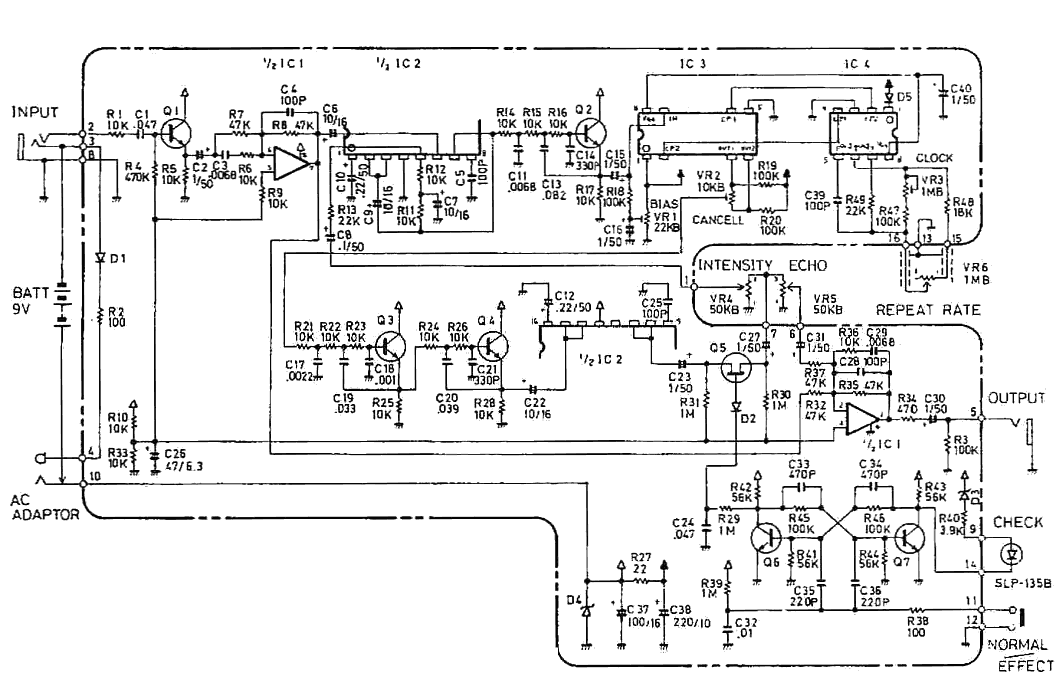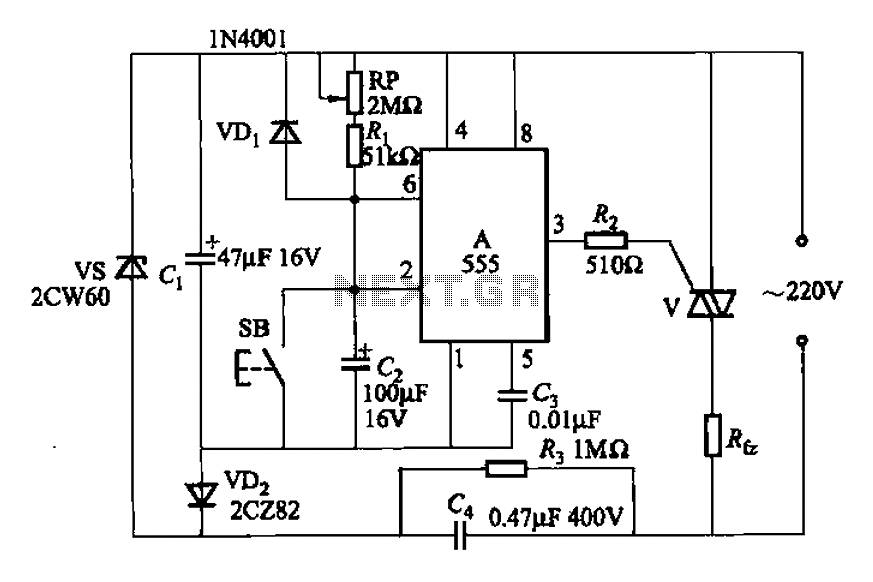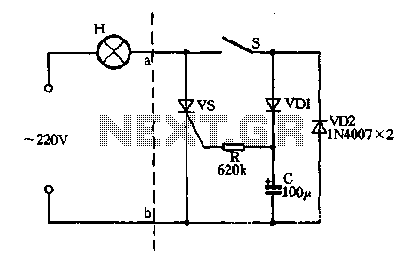
Car Interior Lights Delay

Most cars lack delayed interior lights. The presented circuit addresses this issue by gradually switching the interior lights on and off. This feature facilitates activities such as locating the ignition keyhole after the car door has been closed. The circuit operates through the door switch, necessitating a slight modification to the wiring of this switch. When the car door opens, the door switch closes the lights circuit to ground. Conversely, when the door closes (and the switch opens), transistor T1, which is connected to the switch, disables T2, keeping the interior light off. Upon opening the door, the switch closes, grounding the base of T1, which turns off the transistor. Capacitor C1 charges quickly through resistor R3 and diode D1, activating T2 to turn on the interior light. When the door closes again, T1 conducts, halting the charging of C1. However, C1 discharges slowly through resistor R5, ensuring that T2 does not turn off immediately. This design allows the interior light to remain illuminated for a short period before gradually extinguishing. The timing can be adjusted significantly by changing the values of R3, R5, and C1. Circuit IC2 can be any n-channel power MOSFET capable of handling drain-source voltages exceeding 50 V; in the prototype, a BUZ74 is utilized, which supports D-S voltages up to 500 V.
The circuit design utilizes a combination of transistors, resistors, a capacitor, and a diode to create a delayed lighting effect for the interior of a vehicle. The core components include:
1. **Transistor T1**: This transistor acts as a switch that controls the operation of T2 based on the door switch's state. When the door is closed, T1 is activated, preventing current from flowing to T2 and keeping the interior lights off.
2. **Transistor T2**: This is the main driver for the interior lights. When T1 is off (door open), T2 is activated, allowing current to flow to the lights.
3. **Capacitor C1**: This component is crucial for the delay effect. It charges quickly when the door is opened, enabling T2 to turn on the lights. The slow discharge through R5 creates the gradual dimming effect once the door is closed.
4. **Resistors R3 and R5**: R3 controls the charging rate of C1, while R5 governs the discharge rate. Adjusting these resistors changes the timing of the light delay.
5. **Diode D1**: This diode allows current to flow in one direction, ensuring that C1 charges properly without discharging back through the circuit.
6. **IC2 (MOSFET)**: The selected MOSFET must handle high voltages to ensure reliability. The BUZ74 is a suitable choice due to its high voltage rating, making it capable of managing the power requirements of the interior lighting system.
The circuit's operation can be summarized as follows: when the door opens, T1 turns off, allowing C1 to charge through R3 and D1, which activates T2 and turns on the interior lights. Once the door closes, T1 turns on, stopping the charging of C1. The slow discharge through R5 keeps T2 active momentarily, allowing the lights to stay on before gradually dimming. This design enhances user convenience, particularly in low-light situations, by providing a more user-friendly experience when entering or exiting the vehicle.Most cars do not have delayed interior lights. The circuit presented can put this right. It switches the interior lights of a car on and off gradually. This makes it a lot easier, for instance, to find the ignition keyhole when the lights have gone off after the car door has been closed. Since the circuit must be operated by the door switch, a sli ght intervention in the wiring of this switch is unavoidable. When the car door is opened, the door switch closes the lights circuit to earth. When the door is closed (and the switch is open), transistor T1, whose base is linked to the switch, cuts off T2, so that the interior light remains off. When the switch closes (when the door is opened), the base of T1 is at earth level and the transistor is off.
Capacitor C1 is charged fairly rapidly via R3 and D1, whereupon T2 comes on so that the interior light is switched on. When the door is closed again, T1 conducts and stops the charging of C1. However, the capacitor is discharged fairly slowly via R5, so that T2 is not turned off immediately. This ensures that the interior light remains on for a little while and then goes out slowly. The time delays may be varied quite substantially by altering the values of R3, R5, and C1. Circuit IC2 may be one of many types of n-channel power MOSFET, but it should be able to handle drain-source voltages greater than 50 V.
In the proto-type, a BUZ74 is used which can handle D-S voltages of up to 500 V. 🔗 External reference
The circuit design utilizes a combination of transistors, resistors, a capacitor, and a diode to create a delayed lighting effect for the interior of a vehicle. The core components include:
1. **Transistor T1**: This transistor acts as a switch that controls the operation of T2 based on the door switch's state. When the door is closed, T1 is activated, preventing current from flowing to T2 and keeping the interior lights off.
2. **Transistor T2**: This is the main driver for the interior lights. When T1 is off (door open), T2 is activated, allowing current to flow to the lights.
3. **Capacitor C1**: This component is crucial for the delay effect. It charges quickly when the door is opened, enabling T2 to turn on the lights. The slow discharge through R5 creates the gradual dimming effect once the door is closed.
4. **Resistors R3 and R5**: R3 controls the charging rate of C1, while R5 governs the discharge rate. Adjusting these resistors changes the timing of the light delay.
5. **Diode D1**: This diode allows current to flow in one direction, ensuring that C1 charges properly without discharging back through the circuit.
6. **IC2 (MOSFET)**: The selected MOSFET must handle high voltages to ensure reliability. The BUZ74 is a suitable choice due to its high voltage rating, making it capable of managing the power requirements of the interior lighting system.
The circuit's operation can be summarized as follows: when the door opens, T1 turns off, allowing C1 to charge through R3 and D1, which activates T2 and turns on the interior lights. Once the door closes, T1 turns on, stopping the charging of C1. The slow discharge through R5 keeps T2 active momentarily, allowing the lights to stay on before gradually dimming. This design enhances user convenience, particularly in low-light situations, by providing a more user-friendly experience when entering or exiting the vehicle.Most cars do not have delayed interior lights. The circuit presented can put this right. It switches the interior lights of a car on and off gradually. This makes it a lot easier, for instance, to find the ignition keyhole when the lights have gone off after the car door has been closed. Since the circuit must be operated by the door switch, a sli ght intervention in the wiring of this switch is unavoidable. When the car door is opened, the door switch closes the lights circuit to earth. When the door is closed (and the switch is open), transistor T1, whose base is linked to the switch, cuts off T2, so that the interior light remains off. When the switch closes (when the door is opened), the base of T1 is at earth level and the transistor is off.
Capacitor C1 is charged fairly rapidly via R3 and D1, whereupon T2 comes on so that the interior light is switched on. When the door is closed again, T1 conducts and stops the charging of C1. However, the capacitor is discharged fairly slowly via R5, so that T2 is not turned off immediately. This ensures that the interior light remains on for a little while and then goes out slowly. The time delays may be varied quite substantially by altering the values of R3, R5, and C1. Circuit IC2 may be one of many types of n-channel power MOSFET, but it should be able to handle drain-source voltages greater than 50 V.
In the proto-type, a BUZ74 is used which can handle D-S voltages of up to 500 V. 🔗 External reference
Warning: include(partials/cookie-banner.php): Failed to open stream: Permission denied in /var/www/html/nextgr/view-circuit.php on line 713
Warning: include(): Failed opening 'partials/cookie-banner.php' for inclusion (include_path='.:/usr/share/php') in /var/www/html/nextgr/view-circuit.php on line 713
